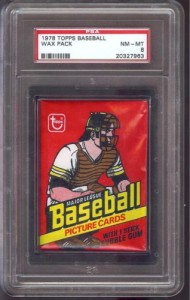In an era of kids seeking out “1 of 1” auto plate patch lavender refractors of their current favorite players, there is little one can do to instill in them a desire to collect items that have intrinsic investment value. For example, one can often find an unopened pack or box of a vintage sportscard product at a fraction of what it would cost to buy today’s high-end rookie cards. The above pack is a perfect example (currently hovering around $80 on eBaY and which could contain gradeable RC of Eddie Murray (#36) and Paul Molitor (#707) to boot!) and provides lesser risk than others; I’ll explain.
When I buy wax product, I make note of several things that could otherwise deter my purchase. Most products prior to 1985 (or earlier) will not have any shrink-wrapping on them. If you see that, consider the reputation of the person with whom you are transacting to buy the box and decide accordingly. Some may very well have legitimate reasons for having had the product wrapped, others may be trying to pawn off pre-sorted (or worse, pre-opened and re-sealed) product on an amatuer collector. My comment about re-sealing is a valid one as well, though it mostly applies when one is considering an individual vintage wax pack purchases. Oftentimes, a collector will stumble across a vintage wax pack with a price that is just too good to be true and may have what appears to be an overage of wax sealing the backing. From time to time, unscrupulous dealers will search these packs, remove key cards or rookies, replace them with “filler” (i.e. base junk) and then re-seal the packs with a warm iron. I cannot stress this enough; know who you are dealing with when you buy vintage product.
Once those hurdles have seemingly been overcome, be sure you know what you are buying. Cards of yesteryear were often released as a part of a multi-tiered series and not all at once like cards of present day (with exception of Topps Series I, II and Update). You will see listings for vintage packs that say things like “Hi Number Series,” or “Series 5.” The message here is that you will need to shop with a checklist in hand if you are looking for a key rookie, else you might wind up paying a price that far outweighs the value of any potential cards you might find (e.g. look at 1961 Nu Card Football, these packs in top notch condition may fetch upwards of $40 with the most valuable card averaging $30-100 in actual book value (oh, and it’s the only one that is that high). One thing to remember, too, is that sometimes the “collectible value” is in the pack being unopened (or, in some instances, it might be a perfect wrapper or box). You will want to know what your desired end collecting result is before just diving in and buying like you’re nuts.
What about if a key rookie is showing through the pack, like in a cello pack? My thoughts on this vary depending upon the day I’m asked, but buy and large I like to buy my rookies individually. I don’t really understand why having an unopened cello pack containing a Cal Ripken, Jr. rookie on top is more valuable than the rookie itself, but then again I was never consulted by the collecting community when this phenomena began occurring with hobbyists. If it’s your thing, I would focus on the ones that contain the most eye-appeal. Just because a pack shows a rookie on top and the pack looks like it is in good shape does not mean that the pack, when opened, will leave the collector with a high professional grade rookie, nor does it mean that the cards below it will similarly be pristine.
I’ll make a final point and move on from my drivel about this topic: If you want to buy unopened product and you want to be assured of its authenticity, be sure to check out unopened packs that have been graded by a reputable third party authentication service such as PSA or SGC. While, no, this is not an absolute guarantee that the products will be as they were the day they left the sportscard manufacturing/distribution facility, it certainly provides a high degree of assurance that the cards you receive a legit. The good thing at that point is that you can either bust the pack open and go for the gold, or you can hold on to it in its sealed slab and know that it will be perfectly preserved until the next time the urge hits you to rip something vintage.
